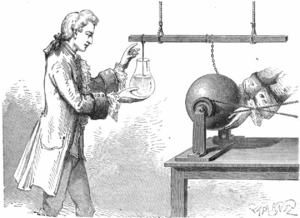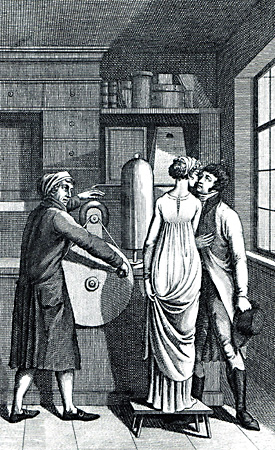Georg Matthias Bose facts for kids
Georg Matthias Bose (born September 22, 1710 – died September 17, 1761), also known as Mathias Bose, was a famous scientist who experimented with electricity. He lived during the early days of electrostatics, which is the study of electric charges that are not moving. He is known for being the first to find a way to temporarily store static electricity. He did this using an insulated (meaning it doesn't let electricity pass through easily) conductor (a material that lets electricity flow). He called this a "prime conductor." His exciting experiments made many people in Germany interested in learning more about electricity.
Contents
Early Life and Discoveries
Georg Matthias Bose was born the son of a merchant. He studied at the Leipzig University and earned his Master's degree in 1727. In 1738, he became a professor of natural philosophy (which was like physics back then) at the University of Wittenberg.
As part of his teaching, he started doing experiments again with a special machine. This machine used a spinning glass globe to create static electricity. He greatly improved this machine by adding a "prime conductor." This allowed the machine to collect and store more of the static charge it made.
Bose was known for being a very exciting demonstrator. He was also good at promoting his work. He wrote to many important scientific groups, like the Royal Society in London. He also connected with similar groups in Prussia, France, Italy, and even Istanbul.
What Was a Prime Conductor?
Bose's first prime conductor was actually a person! An assistant would stand on a block of resin, which is a good insulator (it stops electricity from flowing). The assistant would hold a metal bar in one hand. With the other hand, they would touch the spinning glass globe.
The electricity created by friction would flow through the assistant to the metal bar. It would then collect on the outside surface of the bar. This idea was similar to an experiment by another scientist, Stephen Gray. But Bose added a metal conductor, which became a much better way to store electricity.
What made Bose's idea new was his use of metal. At that time, many scientists thought only insulators (called "electrics") could successfully collect static electricity. They believed metal conductors would lose any charge quickly. People didn't fully understand that charged objects needed to be kept away from electrical contact with the ground. Later experiments showed that the amount of charge stored depended on the outside size of the conductor, not its weight. This is because like charges push away from each other, so they gather on the outer surface.
From 1742 to 1745, Bose actively promoted the study of electricity in Germany. He became famous for his amazing experiments. One popular demonstration involved setting fire to alcohol floating on water. He did this using a spark from his friction machine that passed through the water. Since water and fire were seen as opposites, this experiment amazed many people. It was talked about widely in scientific letters.
The Electric Kiss Demonstration
Bose's "Electric Kiss" demonstration was very popular with audiences. It was a fun twist on Stephen Gray's "Flying Boy" experiment. Here's how it worked:
- A young lady would be asked to stand on a block made of insulating resin.
- She would then be given a moderate static charge from a spinning glass globe.
- Next, a young man from the audience would be invited to give her a kiss.
- When they kissed, both the lady and the young man would receive a small, surprising electric shock!
This demonstration was a great way to show how electric charge could build up. It was also entertaining, which made it a favorite for all electrical showmen and science demonstrators.
The "Beatification" Effect
One of Bose's public demonstrations was called "Beatification." Bose kept the method a secret for a while. Eventually, people accused him of faking it. So, he shared the technique with a colleague. This colleague then published it in the Royal Society's Philosophical Transactions.
This demonstration was an advanced version of his Prime Conductor idea. A person wearing a metal helmet or a suit of armor would sit on a very insulated chair. They would then receive a high level of static charge. This charge was strong enough to create small sparks and glowing lights around the metal surfaces.
Bose later admitted he had made the description a bit more exciting than the actual effect. He explained:
Now, sir, it is true that I have embellished a little my beatification by my style and expressions; but it is also true, that the basis of the phenomenon is constant. I found in our armoury at Leipzic, [sic] a whole suit of armour, which was decked with many bullions of steel: some pointed like a nail: others in form like a wedge; others pyramidal.
In the dark, you well know, that not all, but very many, of the said bullions will sparkle and glister with tails like comets: and it is clear, that when the electricity is very vigorous, the helmet on the head of the person electrized will dart forth rays like those round the head of a canonized saint; and that is my beatification.
Basically, in the dark, the metal points on the armor would sparkle and glow when charged. The helmet on the person's head would even seem to shoot out rays of light, like a halo around a saint.
The Leyden Jar Invention
News of Bose's alcohol experiment quickly reached Pomerania. There, a church dean named Ewald Georg von Kleist was also experimenting with a friction generator. He had hung a large stove-pipe above his machine using silk threads. By chance, this pipe turned out to be a great shape and size for a prime conductor. It could collect a lot of charge.
Von Kleist wondered if Bose's idea of sending electricity through water to flammable liquids could also work to store electricity in a small medicine bottle filled with alcohol. He knew the glass bottle would act as an insulator, stopping the electricity from escaping. So, he put a cork in the bottle with a nail sticking through it. The nail touched the alcohol inside.
He held the bottle in one hand and touched the nail to his prime conductor. Nothing happened right away. But as he carried the bottle into a dark room, he saw a faint glow. This made him think the alcohol was charged. When he touched the nail with his free hand, he got a very strong shock! He later wrote that it threw him across the room.
Von Kleist had accidentally invented the Leyden Jar. However, he didn't realize how important his hand was. His hand, cupped around the outside of the bottle, provided the necessary outer conductive part. This allowed the Leyden Jar to store a huge amount of charge.
After such a strong shock, he was naturally afraid to hold the bottle again. He also seemed unable to repeat the experiment. When he told other scientists about his discovery, they were also careful not to hold the jar. For a while, they couldn't repeat the experiment either.
Von Kleist had studied at the University of Leyden. It is believed he shared his findings with former students there, like Andreas Cunaeus (a lawyer) and Professor Jean Allamand (a theology professor). Allamand tried to repeat the experiment with a glass of beer and eventually succeeded.
Cunaeus and Allamand sometimes worked with Pieter Musschenbroek, a physics professor at Leyden University. It took them some time to discover the secret of the Leyden Jar. They finally understood that the outside conducting surface (like a hand) was crucial. It prevented "electrostatic backpressure" and allowed the jar to store a lot of charge. Because of their work, the Leyden University experimenters received most of the credit for the invention.
Later Life and Legacy
In 1744, Bose published his main works on electricity as pamphlets in London and Paris. Sadly, many of his writings were lost later on. Today, he is mostly remembered for his amazing public demonstrations rather than for his scientific discoveries. In 1757, he was elected a Fellow of the Royal Society of London, a very important scientific group.
In 1760, during the Seven Years' War, Bose was taken from Wittenberg by Prussian forces. He was held as a hostage in Magdeburg. This was, ironically, the same place where Otto von Guericke had done his famous sulfur ball experiment. Georg Matthias Bose died in Magdeburg two years later, in 1761.
Images for kids




